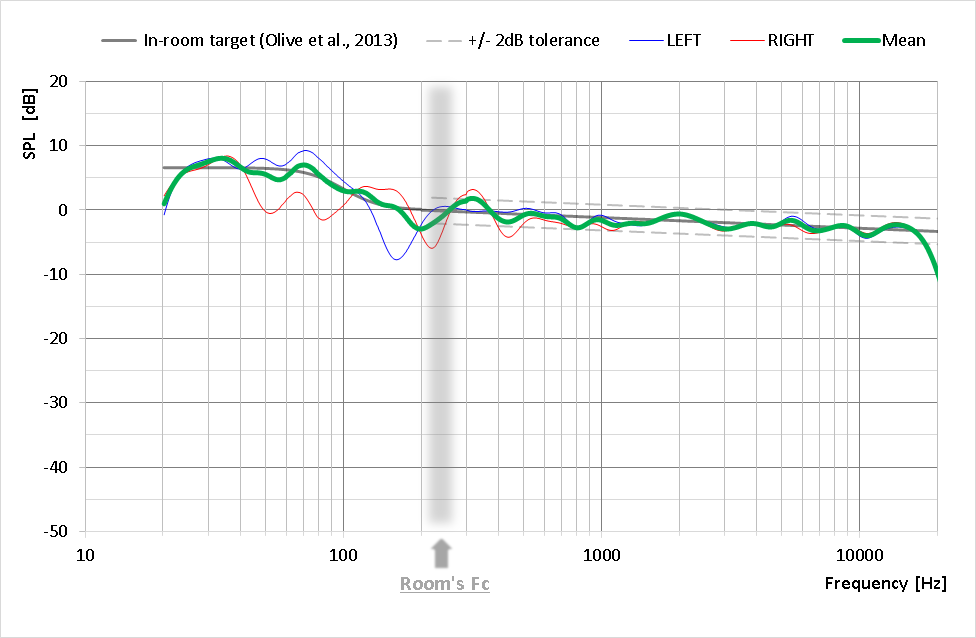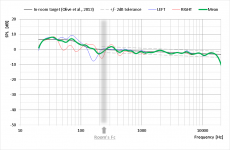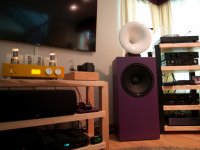At the end of the day, it is all about the pressure exerted on your two ears over time. There is nothing magical about horns. Don't be fooled. Well-designed direct radiators can sound just as good.
Personally, I have been through the journey, starting with direct radiators, then horns, and now back at direct radiators, though of a specific kind
http://www.diyaudio.com/forums/multi-way/284371-corner-floor-ceiling-line-array-using-vifa-tc9.html
Thanks for reminding me of need for this acoustical room treatment. It will no doubt be essential for success when I install my horn system.Most horn systems being discussed here do not solve the more egregious problem of floor and ceiling reflections. Side-wall reflections are not a detriment to the sound; if you prefer to not have them, and it is really just a preference, they can be easily absorbed or diffused. Even Earl uses floor absorbers and ceiling diffusers to tackle the floor and ceiling reflections.
The ones I heard had the treble highly emphasized
About 3 dB too high, by my guesstimate. The exhibitors may have twiddled with the level during the show, since the Ionovac is self-powered (basically a shortwave AM transmitter that ionizes a few cc's of air). The temptation with any supertweeter is to turn it up a few dB so you can hear it do its thing. Not that different than turning up the sharpness control on a HDTV.
What I did hear was clean as a whistle (no apparent distortion or overload), and no issues from the vertical diffraction horn. I think the absence of a hard, reflective phase plug probably makes a difference.
Credit where it's due to the Wavelength electronics (source and amplifiers). Very transparent, dynamic, and with good tonality.
Last edited:
Hi Lynn,
Seeing the beyond Ariel thread compelled me to pen a brief 'thank you' directed to you. Back in the early days of the Ariel I built a pair and fell in love with the sound. I had never really heard tube based HiFi before, nor speakers of the quality of the Ariels. Frankly, it all had a profound effect on me. After listening to the Ariels for a few years--trying different amps and pre amps, turntables, cartridges, etc. with them, I moved on to other speakers of various types--always looking for that synergistic combination that would totally enthrall. And, like many others, I lost my way.
In the last month, I went back to where it all started for me. I put the Ariels back in play, dragged out the monstrous W75 Allan Organ 6550 ultralinear amps modified to triode mode and am trying to get my Dynaco Pass 3x pre amp dialed in. Even with this 'work in progress' pre amp situation I am enjoying beyond description the sound being created.
So, just wanted to tell you how much your selfless contributions have given me so much joy.
Thank you.
Seeing the beyond Ariel thread compelled me to pen a brief 'thank you' directed to you. Back in the early days of the Ariel I built a pair and fell in love with the sound. I had never really heard tube based HiFi before, nor speakers of the quality of the Ariels. Frankly, it all had a profound effect on me. After listening to the Ariels for a few years--trying different amps and pre amps, turntables, cartridges, etc. with them, I moved on to other speakers of various types--always looking for that synergistic combination that would totally enthrall. And, like many others, I lost my way.
In the last month, I went back to where it all started for me. I put the Ariels back in play, dragged out the monstrous W75 Allan Organ 6550 ultralinear amps modified to triode mode and am trying to get my Dynaco Pass 3x pre amp dialed in. Even with this 'work in progress' pre amp situation I am enjoying beyond description the sound being created.
So, just wanted to tell you how much your selfless contributions have given me so much joy.
Thank you.
Personally, I have been through the journey, starting with direct radiators, then horns, and now back at direct radiators, though of a specific kind
http://www.diyaudio.com/forums/multi-way/284371-corner-floor-ceiling-line-array-using-vifa-tc9.html
Do you have pictures of your floor to ceiling array?
New project along the lines of the BTA... or "the Beryllium project"!
Hi all,
I have just embarked on a new project... or rather, a substantial upgrade of my existing 3-way 'speakers.
Basically, I'm going to move to a beryllium diaphragm large-format compression driver AND a beryllium ribbon tweeter.
If anyone's interested, you can read the details in this thread and here.
Both links are work-in-progress... stay tuned for updates
Marco
Hi all,
I have just embarked on a new project... or rather, a substantial upgrade of my existing 3-way 'speakers.
Basically, I'm going to move to a beryllium diaphragm large-format compression driver AND a beryllium ribbon tweeter.
If anyone's interested, you can read the details in this thread and here.
Both links are work-in-progress... stay tuned for updates
Marco
At the same RMAF that I met Lynn, some guy walked into my room, listened for a few seconds and claimed (loudly) "nothing worthwhile listening to in here!" That was when I decided not to ever do another Hi-Fi show.
I missed this previously, so sorry for the late reply.
If it was my demo, I would quietly ask the people in the room: 'Do you agree, folks?' Most, if not all, will probably disagree, and then that guy's credibility will take a serious hit (if any of them see him again). I bet he was a rep or dealer for a rival company. Either way, people would then look at him in a different light, and be able to continue enjoying your demo. I have reached the stage in my life where I don't let any silly comments put me off or irritate me. As Dr. Kent Hovind said, I 'eat the meat and spit out the bone'.
Hi all,
I have just embarked on a new project... or rather, a substantial upgrade of my existing 3-way 'speakers.
... stay tuned for updates
All done!
Here's the finished 'speaker:
An externally hosted image should be here but it was not working when we last tested it.
And its passive crossover:
An externally hosted image should be here but it was not working when we last tested it.
The in-room response conforms to the "preferred target" according to Olive et al. (2013):
Attachments
Hi,
I see, you are prolly using two of these loudspeakers in a common stereo setup. But in that case the following amplitude response plot

is wrong for monophonic content. The plot should show a comb-filter, no matter how flat a single loudspeaker may plot.
Uli
Right - but my intention with the green line was to show that the "average" trend, discounting the differences due to the asymmetrical placement with respect to the side walls, closely matched the Olive et al. target.
Also, when summing sound power outputs one should keep in mind that dB = 10*log(Power). Hence, the Power values should be summed, and then if desired a new dB value computed (the individual dB values cannot be added together to derive a "mean value"!)
Hi Lynn,
Seeing the beyond Ariel thread compelled me to pen a brief 'thank you' directed to you. Back in the early days of the Ariel I built a pair and fell in love with the sound. I had never really heard tube based HiFi before, nor speakers of the quality of the Ariels. Frankly, it all had a profound effect on me. After listening to the Ariels for a few years -- trying different amps and pre amps, turntables, cartridges, etc. with them, I moved on to other speakers of various types -- always looking for that synergistic combination that would totally enthrall. And, like many others, I lost my way.
In the last month, I went back to where it all started for me. I put the Ariels back in play, dragged out the monstrous W75 Allan Organ 6550 Ultralinear amps, modified to triode mode, and am trying to get my Dynaco PAS-3X preamp dialed in. Even with this 'work in progress' preamp situation I am enjoying beyond description the sound being created.
So, just wanted to tell you how much your selfless contributions have given me so much joy.
Thank you.
And thank you for the very kind letter; I really appreciate it. It makes me feel good that a speaker I designed 24 years ago brings people a lot of happiness.
Although I retired back in the Nineties, there are still plenty of things going on around here in Colorado, where I live now. I have to admit the Ariels still sound so good I don't have a huge incentive to make the final push on the "Beyond" project ... besides, other people, including Gary Dahl, have gone ahead and built them and are very happy with them. Gary has auditioned both systems, at my house and at his place in Washington State, and reports they are pretty similar except for the solidity and power of the bass, which is what you'd expect. The Ariel is based on a minimonitor and voiced to sound like stacked Quad ESL 57's, after all, while the Altec 416-based system is more like a classic large-format studio monitor.
I'm still at the stage of contemplating a dual 15" woofer version of what Gary has, with auxiliary subwoofers coming in around 40~60 Hz, wherever they best match the in-room rolloff of paired Altecs in closed boxes. Weirdly enough, I find my existing REL Strata II subwoofers best match the Ariels with a 40 Hz crossover; I've tried 50 and 60 Hz, and there's just too much overlap. I expect the closed-box Altec 416's will have very similar LF in-room rolloffs, when all is said and done.
Last edited:
Hi,
I see, you are prolly using two of these loudspeakers in a common stereo setup. But in that case the following amplitude response plot
is wrong for monophonic content. The plot should show a comb-filter, no matter how flat a single loudspeaker may plot.
Uli
Sorry, but I don't get this. If I play two identical loudspeakers spaced apart with a mono signal (same to both speakers) and measure directly between them I will see comb filtering? Why would that be?
You would have to be precisely an equal distance between the two, but that's doable. I've done it and no comb filtering.
Sorry, but I don't get this. If I play two identical loudspeakers spaced apart with a mono signal (same to both speakers) and measure directly between them I will see comb filtering? Why would that be?
You would have to be precisely an equal distance between the two, but that's doable. I've done it and no comb filtering.
I agree completely with Dr. Geddes. Back at my time at Audionics, we measured amplitude and phase-match between production pairs of speakers by flipping one of them out-of-phase, and looking for a 20 dB (or better) null across the working bandwidth of the speakers. If we had a bad driver or crossover component, you couldn't get a null, and it was flagged for repair or rebuild.
Naturally, when the one speaker of the pair was returned to normal in-phase operation, response was summed and quite smooth (provided the microphone was precisely centered and crossovers were working correctly).
P.S. This production test was done with an old Altec 1/3 octave realtime analyzer, a calibrated pink-noise source, and a B&K calibrated microphone in a quiet part of the factory. It made sure the customers always received speakers with flat response and accurate pair-matching.
P.P.S. There was a time when the production workers dropped the B&K one time too many and it quit working. We sent it back for servicing, and while it was gone, mooched various studio microphones like the expensive Sony condenser mike and assorted others. None of them worked; they were ripply and all over the place on the absolutely critical 1~10 kHz range. So the production line stayed closed until we got the "real" microphone expedited-shipping back to us. I was kind of surprised the $1000 professional studio mikes were as bad as they were; completely unusable for speaker testing (this was before cheap electrets were on the market).
Last edited:
Lynn,
It's been a long time. I built your design using the GPA 416 alnico , Radian 745neo BR , and (2) Rythmik subs. I originally built the posted crossover and later with Dave Slagel's measurement assistance went to a 2nd order low pass and first order high pass( Jupiter copper foil) with a Slagel autoformer (-18 db at 700 hz )I'm very happy with the speakers and the synergy with the Line Magnetic 518 ,845 amp . I primarily listen to vinyl. However, when going digital I'm still using the NM 24 with Mundorf Silver Oil caps, Amprex tubes and the Monarchy AC regenerator as suggested by Mr. Poon.
Thanks again to You and Gary and all others that helped create this excellent speaker.
Greg
It's been a long time. I built your design using the GPA 416 alnico , Radian 745neo BR , and (2) Rythmik subs. I originally built the posted crossover and later with Dave Slagel's measurement assistance went to a 2nd order low pass and first order high pass( Jupiter copper foil) with a Slagel autoformer (-18 db at 700 hz )I'm very happy with the speakers and the synergy with the Line Magnetic 518 ,845 amp . I primarily listen to vinyl. However, when going digital I'm still using the NM 24 with Mundorf Silver Oil caps, Amprex tubes and the Monarchy AC regenerator as suggested by Mr. Poon.
Thanks again to You and Gary and all others that helped create this excellent speaker.
Greg
Attachments
Lynn,
It's been a long time. I built your design using the GPA 416 alnico , Radian 745neo BR , and (2) Rythmik subs. I originally built the posted crossover and later with Dave Slagel's measurement assistance went to a 2nd order low pass and first order high pass( Jupiter copper foil) with a Slagel autoformer (-18 db at 700 hz )I'm very happy with the speakers and the synergy with the Line Magnetic 518 ,845 amp . I primarily listen to vinyl. However, when going digital I'm still using the NM 24 with Mundorf Silver Oil caps, Amprex tubes and the Monarchy AC regenerator as suggested by Mr. Poon.
Thanks again to You and Gary and all others that helped create this excellent speaker.
Greg
Hi Greg,
That's a cool purple (?) 416 enclosure
 .. I like it. Is it sealed, br, or mltl? Did you use some EQ on the Radians? Thanks..
.. I like it. Is it sealed, br, or mltl? Did you use some EQ on the Radians? Thanks..I had to try a bazillion iterations of crossover prototypes to get the 745neo and azurahorn to work well and similarly settled on a single small cap with lpad crossed to a 10" midwoofer with a coil and cap crossed pretty high. But I like it and after a couple of decades of relentless tinkering it's pretty much an end game system for me.
Looks really sharp in purple!
I did my last speakers (my own set) in candy purple with metal flake and they are completely awesome. Wood cabinets are so 70's.
- Home
- Loudspeakers
- Multi-Way
- Beyond the Ariel

